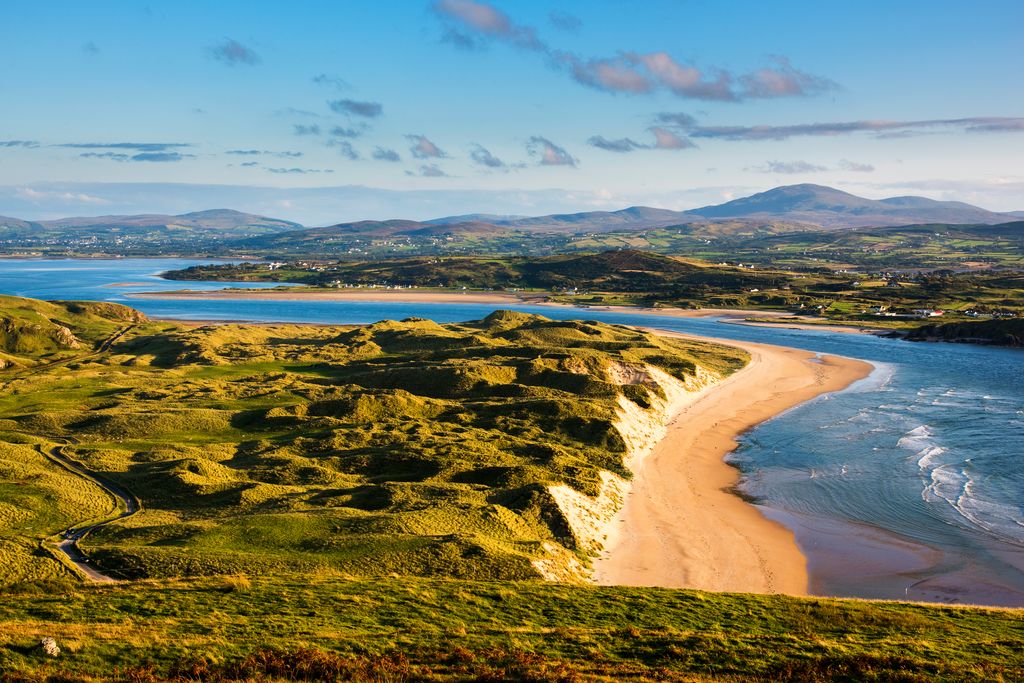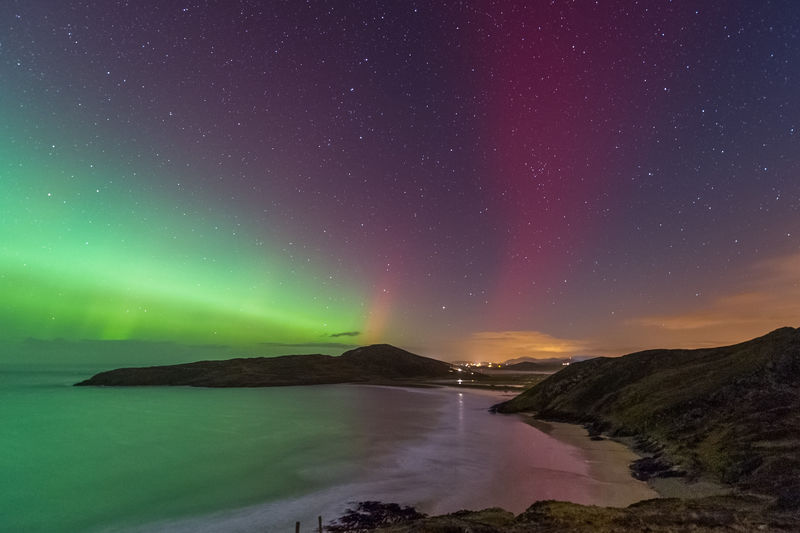Donegal is a vast and varied county it’s real beauty almost hidden away in Ireland’s top corner pocket. The only way to really see and “feel” this wonderful region is on the hiking trails in County Donegal. With the many divisions in Ireland it is often referred to as, ‘the lone county’, as it seems to be cut off from southern Ireland, the republic. Donegal has a spectacular coastline for hiking, with safe, quiet, sandy beaches hiding amidst its rugged shores.
Inland lies a tranquil land rich in heritage and folklore with a wealth of culture and a strong sense of its own identity and uniqueness which is best explored on foot. The county is very sparsely populated, with large tracts of land being uninhabited and a good deal of the open land and grazing country covered by blanket bogs which makes this the ideal hiking holiday location.
So, immerse yourself in this distinctive land and hospitable people exploring all the sights and sounds that this beautiful county has to offer and as the saying goes, “Up here it’s different…”
Glencolmcille
This Gaeltacht village gets its name from St. Colmcille who retreated there during the 6th century. It has one of the best collections of Early Christian pillar stones, spread over the valley located at the 13 stations of the pilgrimage. This pilgrimage takes place every year on the 9th of June – the feast day of St. Colmcille.
The pilgrimage – ideally done at midnight, in the dark preceding the dawn on the saint’s day – is nowadays done in the daylight, but still holds all the ancient traditions from the 8th century.

Slieve League (Sliabh Liag)
Donegal has some of the finest cliff scenery in Ireland, the most famous being the cliffs of Slieve League. These spectacular sea cliffs are among the highest in Europe, with a sheer drop of 600 metres to the sea. You are rewarded for your hiking to the numerous viewing pints where the sky opens up to the views that stretch towards the horizon.
On the high slopes of Slieve League there are remains of an early Christian monastic site, with chapel and beehive huts and there is evidence that the surrounding areas were used as a site of pilgrimage even before the arrival of Christianity.
At Carrigan Head, on the way to the main viewing area, you can see a Signal Tower built in the early years of the 19th century to watch for a possible French invasion. Close to the viewing area you can see stones, which marked out the word ‘Éire’ as a navigation aid for aircrafts during WWII.
Glenveagh National Park
Glenveagh National Park is one of six national parks in Ireland. Situated in the Northwest of Donegal, Glenveagh encompasses some 61 square miles in the heart of the Derryveagh Mountains. Such a great wilderness for hiking is a treasure trove of many different species of plants and animals.
These lands were managed as a private deer forest before becoming a national park in 1975. With the completion of public facilities Glenveagh National Park was officially opened to the public in 1986.
Glenveagh Castle & Gardens
Glenveagh castle and its exotic gardens, which rise like an apparition over Lough Veagh, were built in the 19th century by John George Adair, a man who was born in County Laois, but who made his fortune in the United States.
He had a castle designed to resemble Balmoral, Queen Victoria’s Scottish highland residence, with a four-story keep and turrets made of thick granite, and placed it in the estate of over 40,000 acres.
Then its two preceding owners who later bought the castle would add to its size and grandeur, creating one of Europe’s most enchanting settings in a place of solitude. In 1975 Henry McIlhenny, who had bought the castle in 1936, agreed to sell the Glenveagh estate to the Irish government, allowing for the creation of a National Park, and then in 1983 gave the castle and gardens to the Irish Nation.

Grianán of Aileach
The origins of the Grianán of Aileach fort are dated back to 1700 BC. It is linked to the ‘Tuatha de Danann’ who invaded Ireland before the Celts. They worshipped Dagda (the Good God) and he too is associated with the origins of Aileach.
It was he who ordered the building of a stone fort to act as a burial monument to his dead son. Legend states that the giants of Inishowen are lying sleeping but when the sacred sword is removed they will spring to life reclaiming their ancient lands. Mr Walter Bernard of Derry restored the stone fort in the 1870’s.
The Inishowen Peninsula
Inishowen is the largest peninsula in all of the island of Ireland. The peninsula includes Ireland’s most northerly point, Malin Head, along with Lagg sand dunes, some of the highest in Europe. On the northernmost tip of Malin Head, called Banba’s Crown, stands a cumbersome 1805 cliff top tower that was built by the British admiralty and later used as a Lloyds signal station. Around it are concrete huts that were used by the Irish army in WWII as lookout posts.
The view to the west takes in, from left to right, the Inishowen Hills, Dunaff Head, low-lying Fanad Head with its lighthouse, the twin ‘horns’ of Horn Head and the twin bumps of Tory Island; in the far distance, to the left of Fanad lighthouse, are Muckish and Errigal Mountains. To the east lie raised beach terraces, and offshore you can see the lighthouse on the remote island of Inishtrauhull.
As wild as the area can get, it also provides solace. It was into Inishowen waters – Lough Swilly to be precise – where sailor John Newton found himself after the ship he was on hit a violent storm in the North Atlantic in 1748. The horrific experience engendered a new faith in God within the young Englishman. It is said that this conversion is what ultimately led Newton to write the epic and very well-known hymn ‘Amazing Grace’.

Northern Lights
The Northern Lights – there’s no light show in the world like it. Think the Aurora Borealis and you probably imagine setting your compass for spots like Scandinavia, North America or Greenland. But they’re not the only places to enjoy the Northern Lights…
Donegal and other parts of Ireland’s nights have begun to light up and waves of beautiful colours have flowed across our (sometimes) clear starry skies. The best places in Donegal to view this captivating natural phenomenon is Malin Head, Tory Island, Arranmore, Mamore Gap, and Dunaff to name a few. Even though it’s not guaranteed that you will be able to catch a glimpse of these lights when you’re in Donegal but keep an eye and an ear out on these links:
And if you’re lucky enough, arm yourself with a flask of tea, a loved one or just bring along your camera and enjoy nature’s natural light show.

Donegal Mountains
The Blue Stack Mountains are a major mountain range in the south of Donegal. The highest mountain in the range is Croaghgorm, which is 674 metres high.
The Derryveagh Mountains are also a major mountain range in Donegal and makes up much of the landmass of the county. The mountains separate the coastal parts of the county from the major inland towns such as Letterkenny. These are favorite hiking locations for Irish walkers and we look forward to introducing all of you to this wonderful Irish hiking location.
Errigal, a 751-metre mountain, is the tallest peak of the Derryveagh Mountains. Errigal is also the most southern, steepest and highest of the mountain chain, called the “Seven Sisters” by locals. The Seven Sisters includes Muckish, Crocknalaragagh, Aghla Beg, Ardloughnabrackbaddy, Aghla More, Mackoght and Errigal. The nearest peak is Mackoght, which is also known as Little Errigal or Wee Errigal.
Errigal is well known for the pinkish glow of its quartzite in the setting sun. Another noted quality is the ever-changing shape of the mountain depending on what direction you view it from. Errigal was voted ‘Ireland’s Most Iconic Mountain’ by Walking & Hiking Ireland in 2009.
For more information on our Donegal holidays or any of our other holidays, you can contact us here.
“I just completed the Donegal guided hike with Linda. I have never had such an amazing vacation…ever. Linda was a fantastic guide, she was a wealth of knowledge of Irish history, legends, archeology, geology and other sundry stories.
She knew just how to encourage and keep us going (usually with a promise of biscuits!)… I enjoyed each and every hike… You will not be disappointed. Thanks a million, Ireland Walk Hike Bike for a fantastic experience.”
– Freda, United States via Tripadvisor.
Visited June 2015





Great blog. Keep them coming. I so agree with what Freda said about her trip. Donegal is a magical, beautiful area of Ireland. Getting to experience under Linda’s guidance and care made the trip even more special!
Thanks Margaret! Yes, everybody had a GREAT time on the tour. We take a lot of pride in taking people to places that show you Ireland at it’s very best.